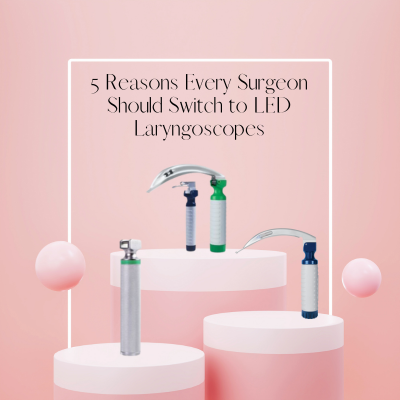In the ever-evolving world of medical technology, staying updated with the latest tools and equipment is crucial for delivering the best patient care. One such innovation that has made a significant impact is the LED laryngoscope. Traditional laryngoscopes have served their purpose, but the advantages offered by LED technology are making them an increasingly popular choice among surgeons.
Here are five compelling reasons why every surgeon should consider switching to LED laryngoscopes.
1. Superior Illumination for Enhanced Precision:
The most immediate and noticeable benefit of LED laryngoscopes is their superior illumination. LED lights provide a brighter and more focused beam, which ensures that surgeons have a clear view of the vocal cords, trachea, and surrounding structures. This enhanced visibility is crucial for performing precise intubations and other airway management procedures.
Unlike traditional incandescent or halogen bulbs, which can produce inconsistent or dim light, LED laryngoscopes deliver consistent brightness, helping surgeons perform with greater accuracy and confidence.
2. Improved Patient Safety:
Patient safety is always a top priority, and LED laryngoscopes contribute significantly to safer outcomes. The bright and clear light provided by LEDs reduces the risk of misidentifying anatomical structures, which can lead to complications during procedures like intubation.
With better visibility, surgeons can avoid damaging sensitive tissues, such as the vocal cords, and ensure that the intubation tube is placed correctly. This precision not only minimizes the risk of injury but also improves overall patient outcomes, making LED laryngoscopes a safer choice for surgical teams.
3. Energy Efficiency and Longevity:
LED laryngoscopes are not only brighter but also far more energy-efficient than their traditional counterparts. LEDs consume less power, which means that the batteries in these devices last longer—often several times longer than those in laryngoscopes with conventional bulbs.
This efficiency is particularly beneficial during long surgeries or in emergencies where uninterrupted use is critical. Additionally, LEDs have a much longer lifespan, reducing the need for frequent replacements and lowering the overall cost of ownership. This combination of energy efficiency and durability makes LED laryngoscopes an intelligent investment for any surgical practice.
4. Ergonomic and User-Friendly Design:
The compact size of LED lights allows for more ergonomic and user-friendly laryngoscope designs. LED laryngoscopes are often lighter and more balanced, making them easier to handle and maneuver during delicate procedures. This improved design reduces the physical strain on surgeons, particularly during long surgeries or complex airway management tasks.
The ease of use provided by LED laryngoscopes enhances the overall surgical experience, allowing surgeons to focus more on the patient and less on adjusting or struggling with their tools.
5. Adaptability and Advanced Features:
Modern LED laryngoscopes come equipped with advanced features that go beyond just providing light. Many models offer adjustable brightness settings, allowing surgeons to customize the illumination to suit the specific needs of the procedure.
Some LED laryngoscopes also incorporate video capabilities, enabling real-time visualization on a monitor. This is invaluable for teaching, training, and ensuring the procedure's accuracy. These additional features enhance the versatility of LED laryngoscopes, making them suitable for a wide range of applications in routine and emergency settings.
Conclusion:
The transition to LED laryngoscope is a step forward in enhancing surgical precision, improving patient safety, and streamlining the workflow in the operating room. With their superior illumination, energy efficiency, ergonomic design, and advanced features, LED laryngoscopes offer undeniable advantages over traditional models.
For surgeons committed to providing the highest standard of care, making the switch to LED laryngoscopes is not just an upgrade—it's a necessary evolution in medical practice. As technology continues to advance, those who adopt LED laryngoscopes will be better equipped to meet the challenges of modern surgery and deliver better outcomes for their patients.




.png)

Comments